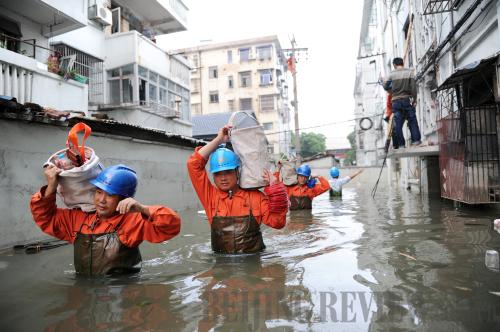|
 |
|
RECOVERY: Workers repair an electric power facility in a neighborhood of Yuyao, Zhejiang Province, on October 11 (XINHUA) |
Recently, Typhoon Fitow, the strongest storm to hit east China since 1951, flooded a number of cities. It made landfall in southeastern Fujian Province early on October 7, soon flooding roads and houses, while causing power failures. In addition, eastern Zhejiang Province was also severely hit.
The typhoon has affected 7 million people in 11 cities across Zhejiang, causing a direct economic loss of 12.4 billion yuan ($2 billion), according to the provincial flood control and drought relief headquarters.
Many trapped residents expressed discontent over the local government's response. They held that the destructive force of Fitow had revealed the lack of adequate relief infrastructure. This has attracted a spare of media attention. The following are excerpts of opinions:
Tang Jiachen (people.com.cn): Despite disaster relief efforts by the local government, a series of problems came to light.
The impact of a typhoon is closely related to disaster prevention and the ability of local authorities. If caught unaware, due to sub-par early warning systems and insufficient resources, even the most economically prosperous city would struggle in the face of natural catastrophes.
In technical terms, early warning systems have come a long way. However, the persistent slow release of information prevents citizens from preparing themselves before a typhoon strikes.
In Yuyao, Zhejiang Province, for example, Fitow cut people off from electricity, water and food for a period of several days. Some even had to sleep on newspapers, while others had to fork out exuberant sums of money to buy essential goods.
In turn, typhoon-affected Shanghai issued a red alert on October 8. However, most schools and companies failed to release timely information on halting classes and production, resulting in the unnecessary exposure of both students and workers to severe storm conditions. Against the backdrop of increased meteorological disasters, it is high time to implement an effective early warning mechanism, enhancing our ability to respond to emergencies. This necessitates that measures be included in city development agendas.
Irrational city planning and unbalanced development have exposed cities to the impact of storms, inland inundation, high temperatures, haze and related meteorological occurrences.
A livable city should not only have towering buildings and flashing neon lights, but more importantly, sound drainage systems, water and power supply networks, efficient information distribution mechanism and emergency planning.
Disaster often acts as a mirror, reflecting wide-spread concern for people in disaster-hit areas, alongside the disadvantages of improper urban management. It is hoped that lessons learnt from Typhoon Fitow would enable Chinese cities to better deal with future natural disasters.
Na Fengyun (Beijing Times): Local authorities should face up to social discontent over ill-preparedness ahead of natural catastrophes.
In Yuyao, an extremely large quantity of rain, which built up over two days, was unable to drain away due to high water levels at downstream Ningbo. Those trapped did not receive timely assistance, with some having to starve until help arrived.
A local official said that they launched an early warning at 7:30 a.m. on October 7 while studying weather reports at the Flood and Drought Prevention Headquarters, though many people failed to receive the information before October 8.
If authorities had taken proper steps in raising awareness and evacuating citizens to safer ground, less people would have been trapped by the storm.
Amid rising anger over inadequate disaster management, local governments should neither deny their inefficiency in relief efforts nor refuse to admit existing problems in emergency response. This is essential to avoid future mishaps.
Citizens are well aware of the challenges facing authorities in dealing with typhoons. Nevertheless, if local governments only emphasize their achievements, while ignoring shortfalls, the future effect of natural disasters may be even worse. Only by facing public concern can governments win the understanding of citizens.
| 